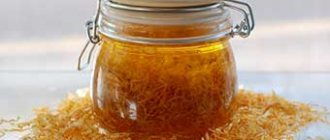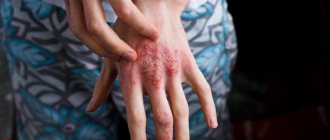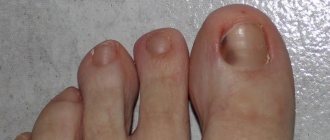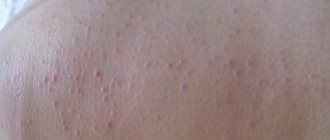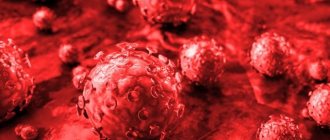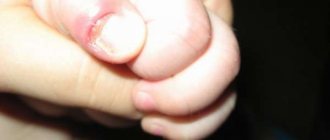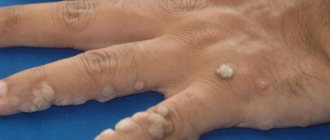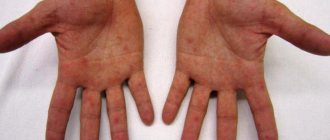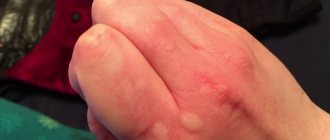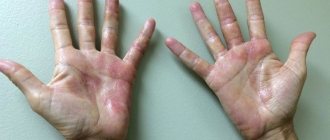All information on the site is for informational purposes only and requires additional consultation with your doctor. Onycholysis (detachment of the nail from the nail bed) is a disease affecting the phalanges of the fingers and toes; onycholysis affecting the big toe has the highest frequency. Pathology manifests itself in the appearance of deformation of the plate; at first it changes its usual pink color, becomes sickly yellow, and sometimes brown, peels off and breaks. The disease can be successfully treated, but the recovery period will be long. The effectiveness of therapy largely depends on the correct identification of the cause of peeling toenails and fingernails.
There are several factors that can cause nails to peel off.
- The main reason is plate injury. A strong blow to any phalanx of the leg or arm, its compression leads to the formation of a hematoma. As a result, a certain amount of blood accumulates under the nail. If the hematoma is not removed in a timely manner, detachment of the nail plate occurs as a complication.
- Improperly performed manicure can lead to injury. A rough cut, filing the plate with a file at an angle, sudden rough movements with a file in different directions, improper processing of the cuticle - all these are provoking factors.
- Chemical burn. It can occur when using aggressive household chemicals and neglecting the safety rules for using potent products. This category includes gels, creams, powders and solutions intended for cleaning plumbing fixtures. Their compositions are especially aggressive; if you do not use protective gloves, there is a risk of developing allergic reactions. In this case, redness appears on a person’s hands, skin irritation and itching appear. Repeated use of aggressive agents without protection causes peeling of fingernails. And this can cause nails to peel off.
- Chronic fungal infections often cause the problem described.
- It has been noticed that diseases of the cardiovascular, digestive and nervous systems will also provoke nail peeling.
Psoriasis, eczema, dermatitis are also accompanied by onycholysis.
Onycholysis has different causes, therefore treatment is carried out taking into account the etiology of the pathology.
Common causes of the disease
Pathology can occur under the influence of unfavorable environmental factors, and also develop under the influence of pathogenic flora. The internal state of the human body is of great importance. Therefore, the common factors are the following options. These are non-infectious causes of the disease in which the nails move away from the skin on the hands:
- Taking certain antibacterial drugs. After completion of the course of treatment, gradual restoration of the dermal appendages occurs.
- Injury to the phalanx of the finger - bruises, fractures of the nail phalanges. In this case, the nail may immediately separate from the bed after the impact.
- Impaired peripheral circulation in the extremities. Such changes are associated with vascular pathology - the formation of blood clots and atherosclerotic plaques.
- Autoimmune diseases that are accompanied by decreased blood flow in small vessels.
- When in contact with aggressive chemical agents - washing powder, detergents, disinfectant solutions, reagents - the nails move away from the nail bed. Treatment begins after eliminating their negative effects.
- Pathology of the gastrointestinal tract with a chronic course of the process.
- Diseases of the respiratory and circulatory system, in which prolonged hypoxia is noted.
- Diseases of the endocrine system - problems with the thyroid gland, hyperglycemic conditions.
- Non-infectious skin lesions - allergic conditions, dermatitis, neurodermatitis, psoriatic manifestations; including long-term local therapy of fingers and palms.
- Manicure using the technique of applied artificial materials, gel polish, acrylic for long-term use; the use of primers to adhere the base base and the nail plate.
- Psycho-neurological disorders.
- Insufficient quality and quantity of nutrition.
- Wearing uncomfortable shoes that do not match the size and fullness of the foot.
The attachment of pathogenic microorganisms can cause detachment. The most common complications are:
- Nails move away from the nail plate due to damage by fungal flora. Treatment must be started as early as possible to prevent relapse of the disease, in order to prevent the fungus from spreading further.
- Penetration of bacterial flora into the site of injury and development of bacterial infection. In this case, patients note that the nails have moved away from the side of the skin.
Important! The combination of several factors leads to a chronic course of the pathological process.
Diseases of the nail plates
Hand skin fungus
There are several nail plate diseases that are worth paying attention to.
Onycholysis
The disease appears when infected with a fungus, injury, or due to heredity. The infection occurs after manicure and extensions done by an inexperienced master who was negligent in the processing of materials. Symptoms of the disease: thickening of the skin at the edge of the finger, change in color of the plate and the appearance of a border between the healthy and diseased area on it. The nail shape first changes, then it can move away, emitting an unpleasant odor.
Nail onycholysis
Onychoschisis
Peeling of the plate occurs in the transverse direction. There is no inflammation or pain. The disease is provoked by mechanical and chemical influences.
Onychomadesis
A serious disease appears simultaneously on all fingers without preliminary symptoms. It develops quickly, provoked by injuries and wounds. Detachment comes from the base and is accompanied by a process of inflammation.
Ingrown nail
The plate grows into the skin of the finger within 6 months, after which yellowness and thickening (or peeling) of the nails appear, and the skin next to them begins to dry. The cause of ingrowth is onychomadesis.
Trachyonychia
The disease is a consequence of immunodeficiency, hormonal imbalance and stress. All fingers can hurt at once. With the disease, the nail plates become dull, become sandy, and look like they are dead. Grooves, cracks and nicks appear. The disease is fleeting.
Trachyonychia of the nails
Onychorrhexis
Characteristic features are the fracture of the plate from the edge to the base, the appearance of cracks. The disease affects older people. The causes are impaired circulation due to injury, eczema, the use of poor quality varnishes and various infections.
Kaylonhinia
The plate is peeling off in the center. Characterized by a saucer-shaped notch. The surface, color and thickness of the plate do not change. The causes of the disease are fungus and infection.
Halalochonia
When sick, the plate softens and breaks easily. The causes of the disease are unfavorable environmental factors, various chronic diseases, heredity, malfunction of the hormonal system, unhealthy diet, and injuries.
General clinical symptoms
The disease can be suspected if there are signs that bother the patient for a certain amount of time. Patients present the following complaints:
- a disorder in which nails peel off, appears for no apparent reason and is difficult to treat;
- the appearance of areas filled with air where the nails have come off;
- the appearance of inflammation in the form of edema, hyperemia, increased local temperature;
- increasing pain and discomfort at the site of pathology, mainly at night;
- periodic bleeding from under the nail;
- changes occur in the nail bed in the form of gray or yellow spots;
- thickening of the nail plate;
- color change from yellow to blue after injury;
- splitting and brittleness of the nail.
Most cases of nail detachment are caused by fungal diseases. Clinical manifestations persist for a long time and are not amenable to cosmetic correction. If you have nail fungus, many remedies are not effective enough. And treating nails with oils does not reduce pathological symptoms.
How does pathology manifest itself?
The peeling process most often affects part of the nail. The nails on the middle and ring fingers are susceptible to negative effects. The large nail is affected less frequently than the others.
Dystrophy of the nail plate is divided into three types:
- Onychomadesis is an inflammatory process at the base of the elbow. It is accompanied by pronounced pain and discomfort.
- Kaylonhinia is the peeling off of the middle part of the nails, under which a blood or air bubble forms.
- Onycholysis is characterized by perpendicular departure of the plate.
Why fingernails come off is difficult to understand at first glance. If it has not been damaged recently, then the cause may be internal. Outwardly, this manifests itself in whitening or yellowing of part of the plate. She becomes thin and fragile. There is air between it and the skin surface. Gradually, the nail cracks and peels off at the ends. This process is accompanied by unpleasant sensations that cause a lot of discomfort.
The skin in the affected area thickens. Bleeding and soreness may occur. In some cases, the skin under the nail comes off. This indicates a severe severity of the disease. With mycoses, there is an unpleasant odor and itching sensation.
! With a fungal infection, the white spots increase faster than in other cases. It is extremely important to see a doctor promptly.
Definition of onycholysis, causes and symptoms
In the absence of timely treatment, the process can spread to more than one phalanx. A pathology in which the nail gradually peels off from the nail bed is called onycholysis. If infection enters the damaged area, there is a high risk of complications in the form of inflammation or the appearance of mycoses.
Most often, such changes occur against the background of other conditions. There are reasons why nails move away from the nail plate:
- Treatment with antibiotics.
- Traumatic injuries
- Allergic and autoimmune conditions - atopic dermatitis, eczema, psoriasis.
Pathological disorders do not bother the patient for some time, given the absence of pain. However, a cosmetic defect remains, which is manifested by the following general symptoms:
- the nail lags behind the nail bed on the hands and feet and cannot be treated;
- the appearance of a patch of air under the plate;
- change in color of the skin appendage.
Why does the nail on the big toe come off?
- The progression of the disease, onycholysis, leads to the destruction of the nail plate and its separation from the nail bed. A void appears under the nail, filled with air.
- The damaged part of the nail is gradually separated from the soft tissues of the finger. In this case, the color of the entire nail changes: it becomes bluish or yellowish.
- The inflammatory process begins with a barely noticeable peeling, which at first can be easily masked with dark varnish. But the fight against nail detachment should be started immediately.
- Onycholysis can affect the entire nail or part of it. The use of various antifungal agents without the prescription of a dermatologist is fraught with a more serious spread of infection.
Damage to the nail plate may be caused by trauma
You cannot start the onycholysis process! You should also not self-medicate: without consulting an experienced specialist, it is impossible to identify the cause of the disease and only a doctor can prescribe the correct treatment.
Causes of onycholysis
The non-infectious nature of the disease is a change in the nail plate under the influence of various external and internal factors:
- The disease may begin to develop after taking antibiotics (cessation of antibiotic therapy leads to restoration of the nail plate).
- External factors include mechanical damage.
- The toenail may begin to separate from the toe due to tight shoes (women are especially likely to experience the toenail on the big toe due to wearing stiletto heels that squeeze the toes).
- The cause may also be a decrease in blood flow to the extremities or a violation of neurohumoral regulation.
- The nail is affected when the skin comes into contact with various allergens (this can be washing powder, a solvent, or a chemical reagent). In this case, the effect of the provoking factor should be excluded.
- Detachment of the nail is possible after infection.
- Fungal skin diseases also cause damage to the nail (spreading, the disease begins to appear on the fingers and toes).
Treatment of nail fungus
Fungal infection of the nails is the most common cause of separation of the nail from the nail bed. 2-5% of people who have weak immunity are susceptible to fungal nail infections.
You can catch this disease in public baths, saunas, swimming pools, sports clubs, even in a hospital shower. Tactile contact with the patient also leads to the development of the disease.
Therefore, you should not wear shoes of a person affected by fungal diseases. It is difficult to know that the nails are affected by fungus simply by visually examining the nail plates. Laboratory tests will be required.
- At the first signs of the disease, you should consult a dermatologist. A sample of the material is examined in the laboratory, which will help determine the causative agent of the disease. Only after this the doctor will be able to prescribe appropriate treatment.
- In addition to affecting the nail plates of the hands and feet, onychomycosis (fungus) affects the skin and hair. Therefore, it is important to start treatment as quickly as possible.
- Self-treatment of the fungus only leads to relief of external manifestations. But the fungus is not completely cured, which ultimately causes the re-development of onychomycosis.
Internal factors for the development of onycholysis:
- disruption of the gastrointestinal tract
- disorders of the cardiovascular system
- chronic diseases
- psycho-neurological disorders
- disruption of the endocrine glands
Skin diseases also lead to the development of onycholysis :
- eczema
- psoriasis
- various dermatitis
- dermatoses
On the toenails, the nail may begin to separate from the nail bed after injury due to mechanical, physical, or chemical factors.
What are the primary symptoms of the disease that allow us to quickly determine the presence of the disease?
- separation of the nail from the tissue of the finger
- the presence of an air-filled void under the nail
- inflammation
- the affected area is bothered by aching pain
- the nail bed may bleed
- the appearance of yellowish or grayish spots on the nail plate
- the nail platinum begins to thicken
- the nail peels off, its structure becomes loose and falls into crumbs
The nail may begin to separate from the finger
- in the middle of the nail plate
- across the growth of the nail plate
- at the very base with severe inflammation
Classification of nail diseases
We have already looked at the main symptoms. Now we need to clarify what the pathological conditions that lead to onycholysis are called. This is necessary to determine measures to prevent nail plate detachment and therapy. In some cases, the doctor may recommend surgical treatment. The following integrity violations occur:
- Kaylonhinia - changes in the middle part of the nail with the formation of an air bubble or the accumulation of a blood clot;
- Trachyonychia is a disorder of the nail structure that changes the appearance of the plate. There is roughness, dull color, furrows and scales appear.
- Onychomadesis is a pathological process in the base area, which is accompanied by signs of inflammation and severe pain.
- Onychorrhexis is characterized by splitting of the nail in the longitudinal direction due to impaired microcirculation in chronic diseases. In most cases, the nails move away from the nail plate. Treatment is aimed at improving peripheral circulation.
- Onychoschisis is a pathological fragility of the regrown part of the plate. Changes are manifested by transverse detachment due to exposure to chemical, mechanical and infectious factors.
- Hapalochinia - thinning and fragility of the plate. The causes of the pathology are multifactorial in nature.
Nail removal
In particularly advanced cases, when the infection is severe or the nail has almost completely come away from the skin, the doctor may recommend surgery to amputate the horny plate. The procedure is painful and is performed under local anesthesia. During the recovery period, therapeutic bandages are applied to the finger using antibacterial agents.
There is a chemical way to remove damaged nails. It is based on the use of keratolytic components that dissolve the horny part. You can purchase drugs such as Nogtimycin, Nogtevit at the pharmacy and, following the instructions, remove the nail yourself.
Removing a nail with a pedicure machine
You can also get rid of the nail plate when it peels off using a hardware pedicure or laser (see photo of big toe nail removal). Find out if this procedure is performed at your nearest cosmetology clinic. Within 2-3 months, a new nail will begin to grow, and if you have eliminated the root cause of the disease, you can guarantee that it will be healthy.
To quickly restore the stratum corneum, it is recommended to take a gelatin solution. Pour in 2 tsp. edible gelatin 100 g of warm water and leave to swell. Then heat the solution in a water bath, add another 100 g of water. When the crystals are completely dissolved, add 1 tsp. lemon juice and drink. Drink gelatin an hour before meals in the morning for 2 weeks. Then they take a break for a week and repeat the course again.
General treatment recommendations
At an early stage, treatment is limited to proper hygiene care and prevention of fungal or bacterial infection. To do this, you must adhere to the following recommendations:
- Keep your hands and nails clean regularly.
- Carefully remove excess areas of the stratum corneum using manicure tools.
- After using scissors or other means, thoroughly disinfect them.
- Do not apply polish or other chemical agents until the nail is completely restored.
- If necessary, cover the area of the damaged plate with an adhesive plaster with a bactericidal strip.
- If inflammation occurs, consult a doctor immediately.
Why does nail peeling occur?
The described disease is characterized by a rapid course. From the moment the peeling begins to the complete loss of the nail, only six months pass. Most often, the thumb is involved in the pathological process, but the remaining nails are gradually affected. This happens for various reasons.
It could be:
- phalanx injury;
- poor quality manicure;
- incorrectly performed nail extension procedure;
- reaction to medications;
- reaction to exposure to aggressive chemicals;
- exacerbation of somatic diseases;
- infectious lesion (fungus).
Treatment of onychomadesis without eliminating the cause does not produce results, therefore, if symptoms of pathology appear, you must seek help from a dermatologist.
Directions of treatment
When a nail moves away from the nail bed on the hand, it is necessary to find the cause and a dermatologist will help prescribe competent treatment. The main condition for recovery is the elimination of unfavorable factors that lead to onycholysis. If adverse symptoms are caused by a fungal disease, the patient must receive antifungal drugs.
Purulent processes require consultation with a surgeon to decide whether to remove the damaged area of the plate. If microcirculation in the extremities is impaired, drugs are used to improve local blood circulation. If detachment of the nail from the nail bed occurs due to injury, the influence of chemical factors or certain somatic diseases, then the main direction of treatment is compliance with hygiene measures and careful care of damaged nails.
Attention! The solution to the problem will be provided only by an integrated approach to the treatment of the disease.
Diagnostics
Nail disease is diagnosed by external manifestations. At the first examination, the doctor visually examines the resulting defect and scrapes the peeling area. Biological material is sent for microscopy. It allows you to confirm or refute a fungal infection.
In the presence of a purulent-inflammatory reaction, pus is collected. He is sent for bacteriological examination. With its help, the causative agent of infection is identified and its sensitivity to medications is determined. If the patient has a history of chronic somatic diseases, specialized specialists are involved in the consultation, and an extensive diagnostic examination is carried out.
Treatments for peeling nails
After eliminating unfavorable factors, if the fingernails move away from the skin, the specialist will determine how to treat the disease and prescribe etiological, pathogenetic and symptomatic therapy. Help consists of using special remedies for nail detachment; they will help you strengthen the plate and prevent the proliferation of pathogenic flora. Use the following options:
- Baths made from herbs or with antiseptic solutions - warm water helps soften and separate the nail plate, improves the penetration of medicinal substances to the affected area. The following solutions have a good effect: 1-2% tinol solution;
- 5% chrysarobin;
- sea salt;
- soda;
- potassium permanganate.
What to do?
If the cause of detachment is injury
In case of incomplete rejection of the nail sheet on the thumb and other fingers in case of mechanical damage, which is not uncommon, the following should be done:
- The affected nail is trimmed daily.
- After which they are treated with a disinfectant.
- The treated area should be covered with a bactericidal patch for the rest of the day.
Surgical methods are used for complete detachment or for a large area of damage . The intervention is carried out by opening the nail bed, removing hyperkeratotic masses, hematomas and the source of contamination.
After surgery, daily dressings are required with mandatory treatment with antibiotics and antiseptics. During the recovery period, solutions with gelatin are used, which have proven to be a very effective remedy.
Microbial damage
Streptococcal or staphylococcal infection
Treatment is carried out using synthomycin gel and heliomycin ointment. Directions for use: treatment of the cuticle and affected area twice a day. Anti-inflammatory drugs are also used in addition to the main treatment.
Effective for local treatment:
- Levomekol ointment;
- preparations based on birch tar;
- Vishnevsky ointment.
Lotions and glycerin dressings are also used.
Candidal mycosis
Basis of therapy: antimicrobial drugs such as:
- “Mikospor” (“Bifonazole”);
- “Loceryl” (varnish is applied once a day);
- “Ketonazole”;
- “Itrazol”, “Itramikol”;
- “Batrafen” (varnish-based ciclopirox).
The use of Exoderil has shown its antifungal effect better than others . The drug is applied to the infected area and nearby areas twice a day.
In severe cases of the disease, antifungal drugs should also be used orally.
Systemic diseases
In this case, onycholysis therapy primarily involves treating the underlying disease that caused the peeling of the nail plates.
Stages of treatment of the disease:
- Vitamin therapy - taking vitamins (C, A, group B, beta-carotene) and microelements (iron, calcium, sulfur, zinc, copper).
- Application of “Solcoseryl” (ointment for external use). The product belongs to the group of biogenic stimulants and activators of metabolism in tissues and has powerful regenerating properties.
- Antihistamines.
- Physiotherapy.
- Nutrition.
If the disease was caused by an allergy or pathology of the digestive system, then it is appropriate to resort to diet therapy.
Can be used as therapy:
- vitamin and mineral complexes;
- antihistamines;
- fish fat;
- Dietary supplements containing amino acids.
Poor nutrition causes slow growth of the nail plate, which leads to its deformation. Patients suffering from onycholysis should include the following nutritional components in the menu :
- gelatin;
- fresh fruits;
- boiled vegetables;
- animal and vegetable proteins;
- nuts, seeds.
Traditional methods of treating nail plate detachment
The main methods consist of taking strengthening baths and lotions.
Here are some recipes:
- Salt bath with potassium permanganate . Dilute a tablespoon of sea salt with hot water and leave for half an hour, then immerse your hands in it. After the bath, wipe your hands dry and apply the medicine.
- Lotion with a paste of oil and garlic . Chopped garlic (5 cloves) is mixed with butter in equal proportions and rubbed into the affected area.
- Iodine . Just apply to your nail plates overnight.
- Propolis is used in the form of night lotions from its infusion.
- Herbal decoction:
- A mixture is prepared from equal proportions of dried oak bark, celandine herb, lilac and calendula flowers.
- The mixture obtained and thoroughly mixed is poured with hot water (temperature about ninety degrees).
- Then the resulting mixture should be placed on the stove and simmered for about ten minutes.
- Then the broth is cooled to room temperature and a twenty-minute therapeutic immersion of the hands is performed.
- Self-massage of fingers . This is done daily. Slowly, gently massage the nails in circular diverging movements in the direction of growth of the nail plate, working more diligently on the fingers with affected nails.
- Gelatin baths . About three grams of gelatin is poured into two hundred milliliters for half an hour. The solution is heated until the gelatin is completely dissolved (without boiling), after which it is cooled. Baths are carried out three times a week.
Medications
The main therapy for some diseases, when detachment of the nail from the nail bed occurs, is the use of drugs. Only a doctor can correctly prescribe treatment. Oral forms and ointments with the active substance are used. There are the following areas of medical assistance:
- Antimycotic agents based on: fluconazole;
- ketoconazole;
- terbinafine;
- intraconazole;
- griseofulvin.
In most cases, the nail detaches from the skin on the hand due to a fungal disease. Even if the pathology was previously treated, it requires long-term therapy for 3-12 months. If nail fungus is detected, the course is continued until the signs of delamination disappear and a healthy nail plate is formed. In order for the infection to be treated quickly and effectively, treatment cannot be interrupted.
- Antibacterial drugs - prescribed when purulent processes appear.
- Complexes containing calcium, iron, vitamins A, B, E - prevent peeling of the nail, it is recommended in any treatment conditions, taking into account the deficiency of useful components.
- Application of medicinal varnish with fungal substances. They are applied to the base and free part during manicure of the nail plate. It not only destroys the fungus, but also heals the nail that has peeled off. Under such treatment conditions, pathogenic flora does not multiply and the situation can be easily corrected.
Drug treatment
Microsporia of smooth skin
Treatment of diseases accompanied by peeling of nails is carried out in combination with medications and according to traditional medicine recipes.
Taking vitamins “A” and “B” will help to quickly get rid of the disease. Medicines with iron and calcium are also prescribed. The use of gels and ointments is effective: “Radevit”, “Heliomycin ointment”.
Heliomycin ointment
Ointments for peeling nails
The drugs Amorolfine, Ciclopirox, and Bifonazole are rubbed into the nail plate. The gel covers the nail with a film, delaying the spread of the disease.
If the disease is fungal in nature, antimycotics are prescribed.
The course of treatment lasts at least a month; treatment cannot be interrupted.
Folk recipes
For many years, people have been using folk remedies for such diseases. If the nails are moving away from the skin on the hands, regardless of the reason, they resort to treatment with alternative methods. Most medicinal preparations include natural components of plant and animal origin, which do not cause adverse reactions and are relatively safe substances. At home, treatment that eliminates detachment can be carried out using the following recipes:
- A bath based on gelatin and lemon juice strengthens the nail plate and promotes the growth of healthy tissue. When preparing the jelly-like mass, it is important not to bring it to a boil.
- Iodine solution - has a disinfecting effect if the fingernail moves away from the skin. Add 5-7 drops of 5% alcohol tincture of the substance to 400 ml of warm water. The procedure is performed within 15-20 minutes.
- Aloe juice - exhibits an antifungal effect, reduces delamination and spread of the process to healthy tissue. Part of the stem is cut in half, applied to the nail and secured with an adhesive plaster or bandage. Leave for 30 minutes, rinse off the residue with warm water.
- A compress made from white cabbage is good at eliminating pain from a bruise, dissolving hematomas, and preventing dissection. Apply to the phalanx overnight.
- A mixture of olive oil and lemon juice is applied to the skin of the fingers and nails and left while you sleep. To ensure that the components act in the place where the nail has separated from the skin and do not spread, cotton gloves are worn on top.
Treatment tactics
The therapeutic regimen is drawn up taking into account the results of laboratory tests. The main emphasis in treatment is on eliminating the cause of the detachment.
If an exacerbation of diseases of internal organs is detected, etiology therapy is carried out. If a fungal infection is detected, systemic antifungal drugs are prescribed, and local treatment with antifungals (gels, ointments, varnishes) is performed. The choice of agent is made based on the results of bacteriological culture.
To relieve a purulent-inflammatory reaction, creams and ointments that contain antibiotics are used:
- 5% heliomycin ointment (has an antimicrobial effect and has a vasoconstrictor effect).
- Syntomycin emulsion (an antibiotic with a pronounced antimicrobial effect).
- Cream "Radevit" is a combination product that has anti-inflammatory and antipruritic effects. Its use helps soothe irritated skin, stimulate local immunity, eliminate discomfort, stimulate recovery processes and intensively moisturize the treated surfaces.
If the nail peeling began after an injury, it is necessary to carefully trim the plate and seal it with an antibacterial plaster. You will have to keep it until a new healthy nail grows.
In parallel with the main treatment, vitamin therapy is mandatory. Preparations of magnesium, calcium, iron, zinc, potassium and retinol are considered especially useful. To consolidate the achieved result, the patient is prescribed gelatin. The course of treatment lasts as long as other medications are taken.
Diet therapy
Adjusting your diet can significantly speed up recovery. It is useful to enrich it with products that contain microelements that nourish the nail plates.
- To replenish calcium, you need to eat cheese, cottage cheese, fish, and seaweed.
- For silicon - parsley, currants, bananas, green salads.
- For iron, it is useful to include in the menu dishes made from liver, beans and spinach, and dried fruits for dessert.
- To replenish vitamins, fresh fruits and berries in any quantity.
A properly selected diet helps reduce the drug load and stop taking synthetic drugs.
Recipes for folk remedies
Regardless of the provoking factors, all patients are recommended to actively use traditional medicine to help strengthen and nourish the nail plate.
These include:
- baths with herbal infusions (chamomile, sage, oak bark) or sea salt (a spoon per liter of water);
- rubbing in vegetable oils (olive, castor, linseed);
- treatment of nails with iodine.
The complex recipe demonstrates good effectiveness.
Experts recommend:
- Prepare a bath with sea salt, drop a few drops of any essential oil and iodine into it, and a few tablespoons of fresh lemon juice.
- Dip your fingers into it and steam your nail plates for fifteen minutes.
- Dry your hands well.
- Rub any nourishing cream into the peeling plate.
- After the cream is completely absorbed, seal the stratum corneum with wax.
This procedure must be done every day for three months.
Preventive actions
In order to get rid of the pathology and avoid repeated cases of the disease, it is necessary to adhere to the recommendations of specialists. The following methods are provided to prevent nails from detaching from the skin on the hands and feet:
- Strengthen immune status.
- Take care of your nails regularly, do manicures and pedicures on time using tools that have undergone the necessary sterilization and disinfection.
- Use antibacterial products after visiting public bathing areas.
- Wear protective gloves when working with household chemicals.
- Conduct timely treatment of chronic diseases that are accompanied by peripheral circulation disorders in the extremities.
- Consume foods rich in vitamins and mineral complexes.
- When applying artificial materials to nails in the form of acrylic or gel polish, you need to periodically “rest” your hands to restore the tissue.
Detachment of fingernails or toenails is a condition that can occur for many reasons. The main task is timely diagnosis and treatment of the pathological condition, which will allow the problem to be quickly dealt with.
The nail has come away from the skin
Unfortunately, a peeling nail at the initial stage does not cause concern for most men and women who are faced with this problem.
Ladies hide a sudden flaw under layers of varnish, and men are simply less picky about their appearance. And they do this completely in vain! If you do not start treating the disease in time, you can lose a healthy nail forever.
Therefore, let's try to understand the causes of this pathology and consider methods of its treatment.
Why does the nail come away from the skin?
This disease can appear in a very short period of time, and it is caused by both internal and external factors. Internal factors are processes or diseases due to which disturbances in the nutrition of the periungual tissues occur, and they begin to die. And external influences include all sorts of external influences, as a result of which detachment occurred.
Internal reasons may be:
- complications of diseases such as dermatitis, eczema, psoriasis;
- consequences of taking antibiotics;
- disorders of the digestive, nervous, cardiovascular and endocrine systems.
External influence factors include:
- fungal infection;
- injuries;
- exposure to chemicals.
The nail may initially detach from the skin in a very small area, and not everyone at first attaches importance to the developing process. But after some time, the void under the nail begins to increase, dirt and infection get onto the subungual tissue, which may even result in the appearance of suppuration.
This type of nail is most often very painful and causes inconvenience in everyday life. The affected nail plate on the fingers prevents you from fully performing daily work, and damage to the toenails prevents you from putting on even the most comfortable and spacious shoes.
If no measures are taken, tissue death will occur over the entire area of the nail, and it will completely disappear. And then, with such severe damage, it is completely unlikely that the new nail will grow healthy, even and beautiful. Therefore, the sooner treatment is started, the higher the chances of success.
With timely therapeutic measures, you can get rid of the detachment without bringing the process to the point of the nail plate falling off.
What to do if the nail comes away from the skin?
It is necessary to treat the disease based on the cause of its occurrence. And a dermatologist will help determine it and make a final diagnosis after the research. If the pathology occurs against the background of psoriasis, dermatitis or eczema, then treatment, first of all, will consist of combating the underlying disease.
It is also necessary to activate the body’s protective properties and increase immunity. Various vitamin complexes will cope with this task perfectly.
They will also be appropriate after taking antibiotics; thanks to a course of vitamins, damaged tissues will be restored and disrupted processes will be restored, which will contribute to recovery.
In the case where nail detachment is an echo of a malfunction of the digestive, cardiovascular, nervous or endocrine systems, it is necessary to diagnose the pathology and pay closer attention to its treatment. Detachment of nails with such a history will be just a concomitant symptom.
Nail plates can also move away from the skin on the hands and feet as a result of physical impact. This condition occurs after injuries or due to wearing tight and uncomfortable shoes. It is better to choose loose shoes, sneakers, boots or other footwear, and to work carefully and carefully to avoid injury.
But still, when peeling occurs for this reason, it is recommended to keep the nail clean and trim it as it grows. The affected area can be protected from germs with a bactericidal adhesive plaster. And if your nails are damaged by chemical reagents, you must wear gloves to protect your hands from aggressive influences.
The nail also needs to be taken care of, as with injuries.
One of the most common causes of peeling nails on both the fingers and toes is a fungal infection. Pathogenic microorganisms get under the nail plate and feed on tissue cells, as a result of which a void is formed under the plate. Fungus can appear not only if hygiene measures are not observed; hands are not protected from infection even with careful care.
The diagnosis can be made after scraping the biomaterial from under the nail and sowing it into a nutrient medium. If after this diagnostic method the diagnosis is confirmed, then various antifungal drugs are prescribed for treatment.
Sometimes therapy in the form of applying an ointment is sufficient, but in some cases, with multiple lesions or reduced immunity, medications in tablets are also prescribed. The most effective substances against fungal infections are ketoconazole, fluconazole, griseofulvin, terbinafine and intraconazole.
On pharmacy shelves you can find ointment with any of the components of domestic or foreign manufacturers. The doctor may also prescribe the drug based on the results of culture of fungal material for sensitivity. It is necessary to apply the ointment to the localized lesion until complete recovery. It is also recommended to steam the nail in warm water, adding soda, salt or potassium permanganate.
You should not apply a bandage to the affected area; the tissue will recover faster with constant access to air. After recovery, it is recommended to smear the nail that peeled off with antifungal ointment for another month to prevent relapse.

